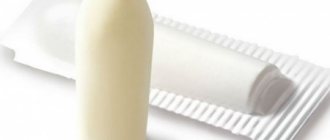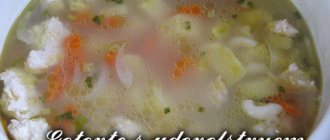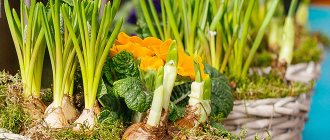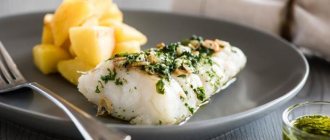When can soups be included in the diet?
The main thing that every nursing woman should remember is that the products she consumes directly affect the health of the baby, since the child’s body receives all the necessary components and microelements along with mother’s milk. Their deficiency leads to a malfunction of the gastrointestinal tract and negatively affects the nervous state.
Immediately after birth, the baby’s organs are poorly developed and the main task of the nursing mother is to facilitate their adaptation. That is why doctors advise sticking to the most balanced diet possible. And in this case, soups come to the rescue. Breastfeeding women need to consume them immediately after giving birth. The main thing to remember when preparing first courses is that the composition should contain only healthy ingredients that cannot provoke the development of an allergic reaction in a newborn.
Red borscht
Product set:
- 5 liters of water;
- 500 g of meat (beef, chicken, turkey);
- 1 small beetroot;
- 4 potatoes;
- 1 onion;
- 2 tomatoes;
- 1 carrot;
- 1 sweet pepper;
- 2 tablespoons of tomato paste;
- 300 g cabbage;
- sunflower oil;
- salt;
- greenery.
Cooking Guide
Soak the meat and let it cook, skimming the foam regularly. Salt it 10 minutes before it’s ready. Remove meat to a bowl. Strain the hot broth and put on fire. Add potatoes and cook until done. Pour boiling water over the tomatoes and then cool them under running cold water. Peel them and cut them into small slices. Chop the onion and fry. Add grated beets and carrots here. Fry the vegetables for 7 minutes. Now pour the tomatoes and tomato paste into it. Simmer the dressing over low heat for about 5 minutes. Next, add bell peppers and fry everything until cooked until the excess liquid evaporates. Add shredded cabbage to the broth with the prepared potatoes and bring the dish to a boil. Next, add the vegetable dressing from the frying pan to the borscht and boil it for about 5 minutes. Sprinkle the dish with dill, onion, and parsley. Place a piece of meat in a bowl, add borscht and season it with sour cream.
What soups are allowed for breastfeeding?
Every nursing mother is interested in which soups are the healthiest for breastfeeding. You can eat almost any food, the main thing is that it is harmless to the baby. If your favorite recipe contains prohibited ingredients, you can replace them with others.
When preparing soup for nursing mothers in the first month, it is important to remember the following rules:
- the best base is low-fat homemade chicken broth;
- Vegetables are very useful for nursing mothers, so they can be safely added to the dish;
- Fresh herbs will help enhance the taste;
- vegetable soup for a nursing mother can be salted and seasoned with sour cream;
- During breastfeeding, it is useful to consume pureed soups. They are easily absorbed not only by the woman’s body, but also by the baby’s digestive system;
- It is not recommended to add rice to first courses, as it can cause constipation;
- One of the safest soup ingredients for nursing mothers are tomatoes that have undergone heat treatment.
Regardless of the recipe chosen, a woman should remember that only fresh ingredients are suitable for preparing soup. Only in this case will it be safe and will benefit the baby and the mother herself.
Both soups and broths can be eaten by nursing mothers only when heated. Hot food can harm a weakened body, and cold food will do no good.
Buckwheat soup with beef broth
Product set:
- 2 liters of water;
- 500 g beef;
- 100 g buckwheat;
- 3 medium sized potatoes;
- 1 onion;
- 1 carrot;
- Bay leaf;
- vegetable oil;
- fresh parsley and dill;
- salt.
Cooking Guide
Cut the meat into pieces and cover with cold water. Soak it for half an hour. Change the water to clean water and place the pan with meat on the fire. After boiling, skim the foam from the surface of the water. Place bay leaf and salt to taste in a bowl. Cook the broth for about two hours. Remove the bay leaf from the pan 10 minutes after the broth boils. Transfer the finished meat to a clean bowl and leave to cool. Strain the broth and put it back on the fire. Place potatoes and carrots, cut into small pieces, into it. Fry the onion in a frying pan with vegetable oil and also add it to the pan. Rinse the buckwheat and add to the soup. After boiling, cook it for 10 minutes, then turn it off and let it brew. Cut the meat into pieces. Eat it with soup, garnishing the dish with chopped herbs.
What ingredients are prohibited?
When choosing recipes for healthy dishes for nursing mothers, it is important to remember that some components of soups can be harmful to the woman herself and the body of the newborn. For the first few months, you should refrain from consuming the following foods:
- beets - this vegetable is a strong allergen and can also cause bloating in a child;
- peas and other legumes are not recommended, since their consumption negatively affects the baby’s digestive system;
- onions and garlic can be eaten starting from the 7th month of feeding;
- mushrooms - the only exception is fresh champignons.
It is also recommended to avoid using herbs and spices when preparing soups. Mayonnaise is also prohibited.
Vegetable puree soup for nursing mothers
Product set:
- 2 liters of water;
- 1 chicken breast;
- 1 onion and 1 stalk of green onion;
- 1 zucchini;
- 3 potatoes;
- 1 carrot;
- salt.
Cooking Guide
Make broth from chicken meat. Remove the finished fillet from the pan and set aside. Strain the broth and boil again. Place carrots, onions, zucchini, potatoes, chopped into pieces. When the vegetables are cooked and soft, remove the pan from the heat and add the meat to it. Grind all products with a blender. Bring the puree soup back to a boil and turn off. Season the dish with finely chopped green onions.
Meat broths
Meat is a valuable source of protein, minerals and vitamins. It ensures the formation and development of cells, strengthens and tones the body, gives vigor and energy, and is responsible for the functioning of internal organs. Meat normalizes metabolism and increases resistance to stress, and meat broth increases appetite, improves digestion and intestinal function. In addition, it is easily absorbed and digested, which is important for the infant’s fragile stomach.
A nursing mother can eat beef and veal, turkey and chicken, and rabbit. At the same time, beef is considered the safest type of meat. This is lean meat that strengthens bones, muscles and blood vessels, lowers cholesterol levels in the blood and improves vision, prevents heart attacks and the development of anemia.
During lactation, it is not recommended to consume lamb and pork, venison and horse meat, goose or duck meat. Such food is difficult to digest and often causes colic in infants. You should not eat wild meat, as it can cause infection. Due to the strong pungency and high fat content, a nursing woman should not eat lard and veins. It is better to avoid offal for the first three months. After introducing offal, this dish can be consumed up to twice a week.
Nutritional properties and possible contraindications
Green beans are a unique vegetable. It combines two opposing properties - nutritional value and low calorie content. This combination is achieved due to a large amount of fiber and “correct” carbohydrates.
In addition to them, the product contains important components, especially necessary for a woman during breastfeeding and her baby:
microelements (iron, magnesium, zinc, potassium, calcium);- vitamins (ascorbic acid, B2, B6, E, PP, folic acid);
- amino acids (arginine, histidine, lysine);
- carotene.
The presence of useful substances makes it a valuable food product. Its use helps improve health in the presence of certain diseases and helps prevent them. Doctors especially recommend eating this vegetable if a young mother has:
- nervous system disorders;
- liver diseases;
- kidney and urinary system diseases;
- bladder or gallstones;
- vascular or heart disease;
- high blood pressure;
- inflammatory diseases;
diabetes;- diseases of the gums and teeth caused by the formation of tartar;
- excess weight;
- irregular cycle of female menstruation;
- decreased levels of red blood cells and hemoglobin in the blood.
There are contraindications for eating green beans. It is forbidden to eat dishes made from this vegetable if diseases are diagnosed or suspected:
- pancreatitis;
- cholecystitis;
- peptic ulcer;
- colitis;
- gastritis.
The main side effect of consuming this product is increased gas formation in the intestines or flatulence.
You should remember this feature of use so as not to get into an awkward situation in a public place or among loved ones. This condition is also observed in babies after feeding by the mother, which leads to their excessive anxiety.
The main requirement for preparing dishes from any beans is their sufficient heat treatment. Eating raw vegetables is very dangerous. The pods and beans contain highly toxic substances that can harm both the young mother and the baby. They irritate the mucous membrane of the mouth, esophagus, and stomach, causing nausea, dizziness, vomiting, and increased heart rate and pulse.
Fish pickle
Product set:
- 2 liters of water;
- 300 g fish;
- 2 pickled cucumbers;
- 4 potatoes;
- 1 parsley root;
- 1 carrot;
- 1 onion and 1 stalk of green onion;
- 4 tablespoons of pearl barley;
- Bay leaf.
Cooking Guide
Boil the fish until tender in salted water and remove. Place the washed pearl barley into the fish broth and bring it to a boil. Next, add diced potatoes to the soup. In a frying pan, sauté chopped onions, parsley root and carrots. Pour the vegetable stock into the broth. Cook it for a quarter of an hour. Cut the pickled cucumbers into small pieces and add to the soup. Add bay leaf. Cook the pickle for another 5 minutes. Turn off the heat and let the dish sit for 10 minutes. Clean the fish from bones. Pour pickle sauce into a plate with fish and sprinkle green onions on top.
We hope you enjoy our soup recipes for nursing mothers.
Fish soup for nursing mothers
Product set:
- 300 g fish;
- 2 liters of water;
- 10 medium-sized potatoes;
- 4 tablespoons of cereals (pearl barley, millet, buckwheat);
- 1 carrot;
- 1 celery or parsley root;
- 2 tablespoons of tomato paste;
- vegetable oil;
- Bay leaf;
- allspice (peas).
Cooking Guide
Boil the fish until cooked and remove from the broth. Place potatoes in it and cook for a quarter of an hour. Next, add salt, cereal, sautéed root vegetables, tomato paste, laurel and pepper into the dish. Cook the soup for another 10 minutes. Pour it into the bowl with the fish. Season the dish with herbs.
Rules for using and preparing broth during lactation
- It is better to start introducing broths and soups when breastfeeding with vegetables. After vegetables they include meat;
- Try a few spoons the first time. If within two days the baby does not show any allergy symptoms or digestive problems, the mother can easily eat this dish without risk to the baby and lactation.
- Broths should be eaten warm. Cold soup will not bring any beneficial effect, and hot soup will only burn the intestines;
- When cooking, use only high-quality products, try to add as little salt and pepper as possible. Avoid hot spices;
- Before cooking, carefully select and wash vegetables. Do not take stale fruits with black spots, dents or rot! Stew the ingredients in water or vegetable oil;
- Soak the meat for one to two hours before cooking. After 3-5 minutes of cooking, drain the broth and add new water;
- Do not use mayonnaise or mustard for dressing! You can add sour cream to the broth;
- If you are used to eating with bread, take products with cumin or bran;
- The norm for broth consumption during lactation is 150 grams per day every day.
Tips and tricks
When introducing any new type of product to a woman's menu during breastfeeding, pediatricians recommend using the principle of gradualness. A young mother should take this into account if she wants to eat green beans, in order to avoid unforeseen reactions of the baby’s body.
You should stop eating this vegetable if your baby develops allergies, diarrhea, or signs of abdominal colic.
In order for the product to bring only benefits to the young mother and baby during breastfeeding, you should adhere to several basic rules for consuming this healthy vegetable during a special period of a woman’s life:
portions of the product for the first doses should be limited in volume; pediatricians recommend taking a few pieces (no more than ten) of cooked vegetables first and monitoring the child’s health;- You should not use dishes with this variety of beans from the first days of the baby’s life; you should start taking them no earlier than 7–10 weeks after his birth; The optimal period is considered to be the age of 4 months, during which time the child’s digestive system is ready to digest the breast milk of the mother who consumed beans;
- features of the product - the long process of digestion by the human body should be taken into account when choosing the time to consume dishes with it; nutritionists do not recommend eating beans in the afternoon;
- Do not consume cooked dishes with this ingredient on an empty stomach.
If the baby does not experience any negative effects when taking beans, the serving size of the dishes can be gradually increased and the combinations of products in their recipes can be diversified. If unnecessary reactions occur in the baby's body, you should stop taking the product.
The time of subsequent use should be agreed with your doctor. In this case, you should especially closely monitor the child’s health, and if negative manifestations appear, completely stop using the product.
Lactation is an important period in the life of every woman. The special connection between mother and child, emotionality, tenderness are clearly manifested at this time. A woman should ensure that her diet is balanced.
The introduction of dishes with beans helps improve the quality of breast milk due to the beneficial nutritional components contained in legumes, leads to an increase in children's immune defense, and the proper development of the baby.










